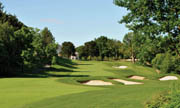
Features
Profiles
Multi-million-dollar makeover has Lambton Golf & CC back in play after year-long shutdown
October 19, 2010 By Mike Jiggens
THE more-than-century-old Lambton Golf and Country Club in Toronto
reopened to its members in August following an entire year without any
golf played.
Established in 1902, the private golf club completed a multi-million-dollar makeover under the supervision of renowned U.S. architect Rees Jones, significantly changing its landscape while addressing some vital concerns. 
Located within the city, the busy Scarlett Road, which runs alongside the former third and fourth holes, had become the unintentional recipient of several errant shots over the years, creating a safety issue for motorists. Poor drainage on the golf course had also reached the forefront of the club’s list of concerns, and a decision was made to bring in Jones to help steer everything in the right direction.
At a cost of $7 million, dramatic and improved changes to the property were made over the course of a year. The main course was closed Aug. 3, 2009 to accommodate the various renovations, including the construction of a new reservoir. Lambton’s shorter nine-hole Valley Course also underwent a number of changes as part of the overall project.
“Rees Jones has done a masterful job of laying our new course over top of our old one,” said Peter Farmer, president of Lambton’s board of governors. “The end result is nothing short of spectacular. There’s a whole new look and feel to the roll of the land, and watching it come back to life has been very rewarding.”
The first phase of the project included changes to holes one through 16 on the main course as well as holes one to four and No. 9 on the Valley course. The new 20.8-million-litre reservoir was also built as part of the project’s opening phase.
The project’s final phase is to include changes to the main course’s two finishing holes as well as completion of the Valley Course, improvements to the short game facility, practice range, putting area, and the relocation of the tennis facility.
The remaining changes will lengthen the main course to slightly more than 7,200 yards from the back tees. Previously, it played at 6,658 yards.
Greens have been enlarged while maintaining a slope of no more than 2.7 per cent. Extensive bunker work has been done which expects to offer members a greater challenge. Several trees were removed to accommodate the changes, and about 1,200 new trees are to be planted on the property. For every tree removed, three new ones were to be planted.
The pending changes to the main course’s 17th and 18th holes were not part of the original $7-million budget and require approval by the membership.
The third and fourth holes, which had presented a safety problem with the adjacent Scarlett Road, have been altered dramatically. Due to the lengthening of the first hole by 74 yards and the elimination of the par 3, 170-yard second hole, the problem holes have become the new second and third holes. Both have been shifted further west of their original position, minimizing the chances for sliced tee shots to reach the road.
In general, the once tight-feeling golf course has been altered to present itself as more of an open concept.
In a question-and-answer session with Jones, he was asked what kind of strategies golfers must consider when playing the newly-renovated golf course.
“Seven of the 11 par fours on the old course played between 373 and 404 yards,” he said. “Two of the remaining four were less than 366 yards, and the other two were over 433 yards. Therefore, there is much wider variety of length on the par fours which will translate into playing a wider range of clubs on them. The greens will have more contour that separates and defines a variety of pin locations on each green. The greens will also be a little larger, and the added contour will make them more challenging.”
Jones said he anticipates the changes to the remaining 17 and 18 holes to complement the renovations already made.
“Hole 17 is going to be a long par three, playing along the edge of a steep slope with a bailout along the left side of the hole. Hole 18 is going to be a 460-yard par four, slight dogleg left that finishes at the back of the clubhouse. These two holes will provide an outstanding and memorable finish to your round at Lambton.”
While the golf course was closed, Lambton’s members were given the opportunity to play at other local courses which offered tee times.
“Our members benefitted greatly from approximately 30 private and public courses around the GTA, offering up over 100 tee times per week in reciprocal arrangements, allowing over 400 Lambton members to golf,” said John Demko, chief operating officer at Lambton. “These ‘friends of Lambton’ will long be remembered for their generosity of spirit.”
The recent series of renovations is an extension of a number of upgrades and modernizations which began eight years ago, including the construction of a new clubhouse and pro shop.
Several other architects have left their stamp on Lambton over the years, including Donald Ross, Stanley Thompson and Tom Bendelow. The club was founded in 1902 by a group of prominent Toronto businessmen led by A.W. Austin, president of the Dominion Bank of Canada. The club has remained at the same Lambton Mills site since its inception.
Print this page